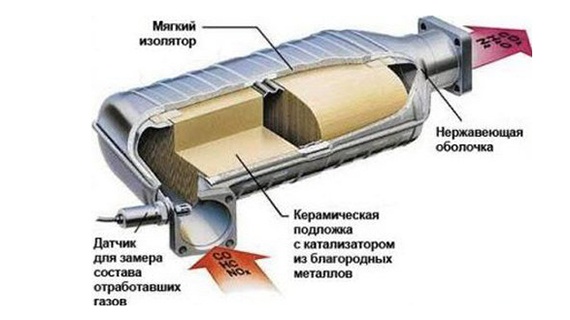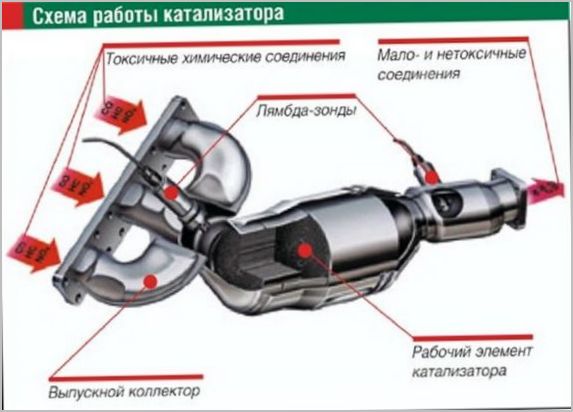
Catalytic converter - its function in the car
Content
Car exhaust contains many toxic substances. To prevent their release into the atmosphere, a special device called a "catalytic converter" or "catalyst" is used. It is installed on cars with gasoline and diesel internal combustion engines. Knowing how a catalytic converter works can help you understand the importance of its operation and evaluate the consequences that its removal can cause.

Catalyst device
The catalytic converter is part of the exhaust system. It is located just behind the engine exhaust manifold. The catalytic converter consists of:
- Metal housing with inlet and outlet pipes.
- Ceramic block (monolith). This is a porous structure with many cells that increase the contact area of the exhaust gases with the working surface.
- The catalytic layer is a special coating on the surface of the cells of the ceramic block, consisting of platinum, palladium and rhodium. In the latest models, gold is sometimes used for plating - a precious metal with a lower cost.
- Casing. It serves as thermal insulation and protection of the catalytic converter from mechanical damage.

The main function of a catalytic converter is to neutralize the three main toxic components of exhaust gases, hence the name - three-way. These are the ingredients to be neutralized:
- Nitrogen oxides NOx, a component of smog that causes acid rain, are toxic to humans.
- Carbon monoxide CO is lethal to humans at a concentration of only 0,1% in the air.
- Hydrocarbons CH are a component of smog, some compounds are carcinogenic.
How does a catalytic converter work
In practice, a three-way catalytic converter works according to the following principle:
- Engine exhaust gases reach the ceramic blocks, where they penetrate the cells and completely fill them. The catalyst metals, palladium and platinum, set off an oxidation reaction in which unburned hydrocarbons CH are converted to water vapor and carbon monoxide CO is converted to carbon dioxide.
- The reducing metal catalyst rhodium converts NOx (nitric oxide) into normal, harmless nitrogen.
- The cleaned exhaust gases are released into the atmosphere.
If the vehicle is equipped with a diesel engine, a particulate filter is always installed next to the catalytic converter. Sometimes these two elements can be combined into one element.

The operating temperature of a catalytic converter has a decisive influence on the effectiveness of the neutralization of toxic components. The actual conversion starts only after reaching 300°C. It is assumed that the ideal temperature in terms of performance and service life is between 400 and 800°C. Accelerated aging of the catalyst is observed in the temperature range from 800 to 1000°C. Long-term operation at temperatures above 1000°C adversely affects the catalytic converter. An alternative to high-temperature ceramics is a corrugated foil metal matrix. Platinum and palladium act as catalysts in this construction.
Resource catalytic converter
The average life of a catalytic converter is 100 kilometers, but with proper operation, it can work normally up to 000 kilometers. The main causes of premature wear are engine failure and fuel quality (fuel-air mixture). Overheating occurs in the presence of a lean mixture, and if it is too rich, the porous block becomes clogged with unburned fuel, preventing the necessary chemical processes from occurring. This means that the service life of the catalytic converter is significantly reduced.
Another common cause of ceramic catalytic converter failure is mechanical damage (cracks) due to mechanical stress. They provoke the rapid destruction of blocks.
In the event of a malfunction, the performance of the catalytic converter deteriorates, which is detected by a second lambda probe. In this case, the electronic control unit reports a malfunction and displays the error “CHECK ENGINE” on the dashboard. Rattles, increased fuel consumption and deterioration in dynamics are also signs of a breakdown. In this case, it is replaced with a new one. Catalysts cannot be cleaned or reconditioned. Since this device is expensive, many motorists prefer to simply remove it.
Can the catalytic converter be removed?
After removing the catalyst, it is very often replaced with a flame arrester. The latter compensates for the flow of exhaust gases. It is recommended to install it in order to eliminate unpleasant noises that form when the catalyst is removed. Also, if you want to remove it, it's best to remove the device completely and not resort to the recommendations of some car enthusiasts to punch a hole in the device. Such a procedure will only improve the situation for a while.
In vehicles complying with Euro 3 environmental standards, in addition to removing the catalytic converter, the electronic control unit must be reflashed. It must be upgraded to a version without a catalytic converter. You can also install a lambda probe signal emulator to eliminate the need for ECU firmware.
The best solution in case of failure of the catalytic converter is to replace it with an original part in a specialized service. Thus, interference in the design of the car will be excluded, and the environmental class will correspond to that specified by the manufacturer.